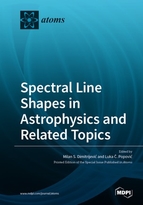Semiclassical Stark Broadening Parameters of Ar VII Spectral Lines
Round 1
Reviewer 1 Report
This paper is responding to a need (especially in astrophysics) to have Stark-Broadening parameters for isolated lines of Ar VII. The authors use the semi-classical impact approximation from a previously published paper. The spectral line full-width at half maximum and shifts of lines are given in a table for a variety of transitions at various conditions.
This work is reasonably well presented and will be useful for other researchers who study these lines. However, one thing missing that would be desirable for users of these tables is a brief error analysis, or at least a statement that says that these FWHM are accurate to +/- x%. Such errors could arise due to the assumptions made in the calculations, including the types of radiator-plasma interactions, or the neglect of the frequency dependence of the electron-broadening operator. The errors need not be stated explicitly, but some quantization of the errors would be sufficient.
In addition, there are some minor spelling/English mistakes: line 21, collisions is misspelled; line 26, innovations is also misspelled; line 38 should read "explained in detail"; line 50, there is a "used" that should be removed so it says "The temperature range is of ..."; the paragraph on line 65 is awkward and needs to be rewritten so that the message is clearer.
Overall, this paper, with some minor revisions, is suitable for publication in Atoms.
Author Response
We are very grateful to reviewer for very useful comments. We answered all his questions and remarks:
1. Reviewer:
This work is reasonably well presented and will be useful for other researchers who study these lines. However, one thing missing that would be desirable for users of these tables is a brief error analysis, or at least a statement that says that these FWHM are accurate to +/- x%. Such errors could arise due to the assumptions made in the calculations, including the types of radiator-plasma interactions, or the neglect of the frequency dependence of the electron-broadening operator. The errors need not be stated explicitly, but some quantization of the errors would be sufficient.
Our answer:
We added the following paragraph:
The accuracy of the semiclassical perturbation method is estimated by comparison with numerous experimental data for different elements and spectral lines,
and is estimated to be 20-30\% (see discussion in \cite{Sa14}). Since Ar VII is a member of magnesium isoelectronic sequence, withrelatively simple spectrum,
we suppose that the error of results shown in Table 1 is not much higher than 20\%.
2. Reviewer:
In addition, there are some minor spelling/English mistakes: line 21, collisions is misspelled; line 26, innovations is also misspelled; line 38 should read "explained in detail"; line 50, there is a "used" that should be removed so it says "The temperature range is of ...";
Our answer:
Corrected. Thank you very much.
3. Reviewer:
the paragraph on line 65 is awkward and needs to be rewritten so that the message is clearer.
Our answer:
The corrected paragraph is:
The obtained Ar VII Stark broadening parameters, shown in Table 1, will be implemented in
the \textsc{STARK-B} database \citep{starkb, Sah15}. This database contains Stark widths and shifts, needed, first of all, for the investigations, modelling
and diagnostics of the plasma of stellar atmospheres, but also for diagnostics of laboratory plasmas, and investigation of laser produced,
inertial fusion plasma and for plasma technologies.
Reviewer 2 Report
Report on paper by Dimitrijevic et al “Semiclassical Stark broadening …”
Stark broadening of spectral lines in laboratory and astrophysical plasmas is the primary tool for determining plasma parameters – especially the electron density. Therefore calculations presented in the paper are important both fundamentally and practically.
The calculations are based on the well-known theoretical contributions to the subject by one of the authors (Sahal-Brechot). Her theoretical contributions to the subject are reliable and time-tested.
This short paper is, generally, well-written. I have only the following few grammar/stylistic comments.
1. Introduction, 2nd paragraph, 1st sentence: instead of “exist” should be “there exists”.
2. Sect. 3, 2nd paragraph, line 3: instead of “laboratory plasma” should be “laboratory plasmas”.
3. Sect. 3, 2nd paragraph, line 4: instead of “laser produced plasma” should be “laser produced plasmas”.
After the authors would take into account the above comments, the paper could be published.
Comments for author File: ![]() Comments.doc
Comments.doc
Author Response
p { margin-bottom: 0.1in; line-height: 120%; }
We are very grateful to reviewer and we answered all his remarks:
1. Introduction, 2nd paragraph, 1st sentence: instead of “exist” should be “there exists”.
Corrected.
2. Sect. 3, 2nd paragraph, line 3: instead of “laboratory plasma” should be “laboratory plasmas”.
Corrected
3. Sect. 3, 2nd paragraph, line 4: instead of “laser produced plasma” should be “laser produced plasmas”.
Corrected






